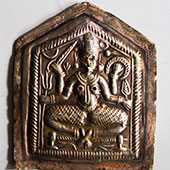Maharashtra is one of the most historically renowned places in India which was used to describe a region which consisted of aparanta, vidarbha, mulak, ashmak assaka and kuntal. Tribal communities of naga, munda and bhil people inhabited this area, also known as dandakaranya in ancient times. Maharashtra is a place where we can experience affluent rituals, traditions, customs and lifestyle. In maharahstrian tradition devatas(gods and goddesses) play an inevitable role. The tradition of worshiping makes maharashtrian culture unique and different from all other regions in India. As per the worshiping tradition of Maharashtra there are some dos and don’ts, there are some rules and regulations which has to be followed. Like any other part of India, Maharashtra is also having temple worshiping tradition but apart from temples every single household must be having a ‘pooja khar’ (sanctum sanctorum) where they worship their gods and goddesses. Sometimes there are 5, 7 or 9 devatas are worshiped at home. The unique and precise methodical worshiping makes the tradition more exclusive and interesting. The most fathomless fact about maharashtrian tradition and culture is adaptability. The willingness to accept people from outside maharashtra and consider them as one among them. Eventually without any external force those people also will adapt the worshiping culture. The deities are classified into few categories they are respectively’Ishta Devata’, ‘Kulaswami or Kulaswamini’, ‘Kaalbhairav or Kshetra Palaka’, ‘Gramdevata’ and ‘Yakshpurush’.
Ishta Devata is the category of gods and goddesses one who consider as their favorite. It can be any form or name of god or goddesses, for example Lord Krishna, Lord Rama, Goddesses Saraswati etc.
Kulaswamini or Kulaswami stands for "family deity who is either a god or a goddess." The word Kuladevata is derived from two words: Kula means clan and Devata means deity. Thus, it can be said that Kuladevatas are deities which are worshiped by particular clans. The deity can be a male, female, animal or even an object, like a holy stone. Hindu families make a pilgrimage to the Kuladevata or Kuladevi temple to obtain the blessing of the deity every year or after an auspicious occasion such as a wedding. Kuladevatas are worshiped in several sects of Hinduism and Jainism. In the state of Maharashtra, the Kuladevatas are mainly manifestations of Shiva or Shakti. Khandoba is the most commonly and widely worshiped deity. Bhavani, Mahalakshmi, Renuka etc are considered as Kulaswaminis respectively.
Kalabhairav or Kshetrapalaka is the guardian of temples. Kalabhairava is the manifestation of Lord shiva and he is believed to be the controller of ghosts, evil souls and spirits. Linga Purana and Shiva Purana contain stories on him. Kalabhairava or Kshetrapalaka is worshiped by every single villager and considered him as ‘Gramadevata’, the guardian of village.
Taak
According to the ritualistic norms and regulations of maharashtrian culture, there are some set of rules which has to be followed by every household when they worship gods and goddesses at home. There are two types of murties(idols/ effigy) of deities. Ishtadevata murti and ‘Taak’ (metal embossed image of gods and goddesses). Ishtadevata murti or the idols of Ishtadevata (favorite deity) can be in metal casting or any other forms but the idols or impression of Kuladevata should not be in any other form except “taak”. “Taak” is pentagon shaped metal embossed image of kuladevatas (family/clan deity). Khandoba, Biroba, Jyotiba, Ravlnadh, Veer, Baapdev etc, are the few names of male manifestations and Mahalakshmi, Renuka, Bhavani, Mariaai, Janaai, Kalkaai, Yamaai, Bolai, Jarimari, Saptamatrika etc, are the female manifestations of supreme power which are worshiped in the form of Kuladevata.
Taak is a pentagon shaped metal embossed effigy of gods and goddesses mostly done in silver and sometimes in gold as well. The geometric shape or the Panchakon (five angles) signifies ‘The panchamahabhootas’. According to Indian philosophy and Hindu mythology the pancha maha bhootas (the five great elements) are used to describe the five great elements that are said to be present in everything in the universe, including in the human body as well as the base of all cosmic creation. Silver and gold signifies the purity and divinity. The back side and sides of Taak is covered and finished with copper which signifies serenity and the interior filling is done by lac which signifies nature and energy.
Jejuri is a city which lies to the southeast of the Pune city of Maharashtra. The town is known for being the venue of one of the revered temples in the state, known as the Khandobachi Jejuri. The temple is dedicated to Khandoba, also known as Mhalsakant or Malhar Martand or Mylaralinga. Khandoba is regarded as the 'God of Jejuri' and is held in great reverence by the Dhangars, one of the oldest tribes in India. Jejuri is the best and unique place to witness the making of divine craft ‘Taak’.








